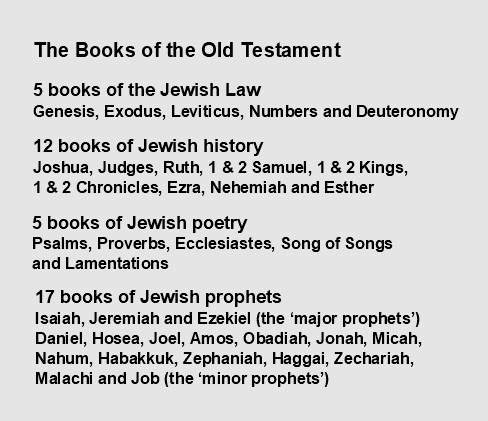The Old Testament
There are 39 books in the Old Testament (the same number as in the Jewish Tanakh):
5 books recounting the giving of the Jewish Law (the ‘Pentateuch’ or ‘Five Volumes’)
12 books of Jewish history
5 books of Jewish poetry
17 books of the Jewish prophets.
Three of these prophetic books are called the ‘major’ prophets (as they have longer prophesies), and 14 are termed ‘minor’ prophets (with shorter prophetic messages).
In the Old Testament the prophetic books are not listed in chronological order. In The Bible Journey, the books of the Jewish prophets are featured in the order in which they were written. This helps us to understand the historical context of these prophesies.
The 39 books of the Old Testament can be summarised as follows:

Fig. 9 The Books of the Old Testament
The Jewish Tanakh
In the Jewish version of the Old Testament (the Hebrew ‘Tanakh’), the authorised books are divided into three sections:
The first 5 books of the Old Testament are known as the ‘Torah’ (Hebrew, ‘Hattora’ or 'the Law’). They retell how God gave the Law to Moses on Mount Sinai, and go on to give details of the 613 ‘mitzvot’ or ‘commandments’ that Jews were implored to keep in their everyday lives. Nehemiah, writing in c.445BC, refers to these five books as “the Book of the Law of Moses” (see Nehemiah 8:1).
The 6 historical books of Joshua, Judges, 1 & 2 Samuel and 1 & 2 Kings, together with the 3 books of Isaiah, Jeremiah, Ezekiel and 12 books of the ‘minor’ prophets are known as the ‘Neviim’ (the ‘Prophets’), as the history books were also considered to have been the work of prophets.
These two sections of the ‘Tanakh’ were recognised as the authorised ‘canon’ of the Jewish scriptures by c.200BC. These were the authorised Jewish scriptures in Jesus’s day, and Jesus referred to them as “the Law and the Prophets” (see Matthew 5:17).
The 5 books of poetry (Psalms, Proverbs, Song of Songs, Lamentations and Ecclesiastes), together with the 8 books of Job, Ruth, Esther, Daniel, Ezra, Nehemiah and 1 & 2 Chronicles are called the ‘Kethuvim’ or ‘K’uvim’ (the ‘Writings’). They were written and used over a long period of time (some of the Psalms are attributed to Moses and David), but were not brought together and authorised as part of the Hebrew scriptures until c.90AD. The authorised three-fold ‘canon’ of Jewish scriptures was called the ‘TaNaKh’ because it consisted of the Torah (the Law), the Neviim (the Prophets) and the Kethuvim (the Other Writings).
The 39 books of the Jewish scriptures (the ‘Tanakh’) can be summarized as follows:

Fig. 9(a) The Books of the Jewish Tanakh
It can be seen by comparing Fig.9 and Fig.9(a) that the Jewish Tanakh and the Christian Old Testament are very similar, except that the books do not appear in exactly the same order.
